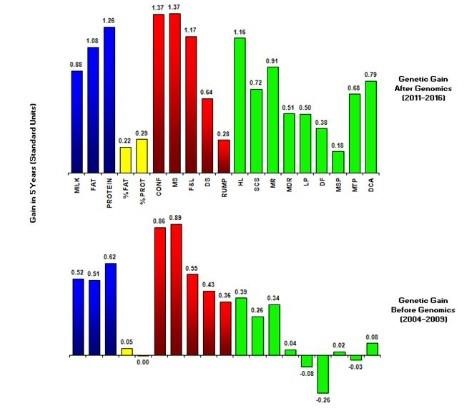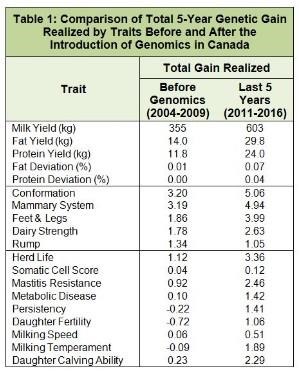- Gains achieved with genomics have been positive for all traits, including lower heritability functional traits. Prior to genomics, gains for most functional traits were slow and even negative for some traits, such as Daughter Fertility. The impressive gain for these low heritability traits is a direct result of the increase in the accuracy of genetic evaluations due to genomics. Overall, the largest gains relative to the five years before genomics are seen for functional traits.
- Gains achieved with genomics were doubled for Fat and Protein Yields while also making considerably higher genetic gains for deviations.
- Gains achieved with genomics were the highest for overall type traits, especially Conformation and Mammary System, but these traits were also achieving the highest rates of genetic progress prior to genomics. These past and continued gains are partially due to the high selection intensity for these traits.
- Gains achieved with genomics were doubled for Feet and Legs, which is the least heritable among the five overall type traits. Since genomics significantly increases the accuracy of published evaluations, the genetic gain realized for this trait has been large.

Another way to compare the genetic gain achieved pre- and post-genomics is presented in Table 1. Here, gains are expressed in the same units as proofs for each given trait. For example, yields are expressed as EBV based on kilograms while most functional traits are expressed as Relative Breeding Value (RBV) points.
In Figure 2 we saw that with genomics, there has been twice the amount of genetic gain realized for Protein yield in terms of standard units. Referring to Table 1, we can see that the combined gain for Protein yield during the five years prior to genomics was 11.8 kg, or around 2.4 kg per year. In the past five years with genomics, the combined gain was 24 kg, or 4.8 kg per year. This means that females born in the last 5 years in a herd with average management are expected to have 305 day lactation yields that increase roughly 5 kg per year, on average. In this case, double the genetic gain translates into double the performance increase for protein yield.
Likewise, when looking at the functional traits, the combined gain for Herd Life during the five years prior to genomics was 1.12 RBV points, or 0.22 RBV per year. Over the past five years, however, with genomics, the combined genetic gain for this trait was tripled to 3.36, or two-thirds of an RBV point of gain per year. Significant gains with genomics have also been observed for other functional traits, meaning that Holsteins today can be expected to last longer in the herd due to improved calving and reproductive performance along with higher resistance to disease.

Genetic gains have increased substantially across the board since the implementation of genomics in Canada. While all traits have benefitted from the increased accuracy the technology provides, this is particularly true for lower heritability functional traits. The increased gain for individual traits translates into a rate of progress that has doubled for both of Canada's national genetic indexes.
Source:CDN